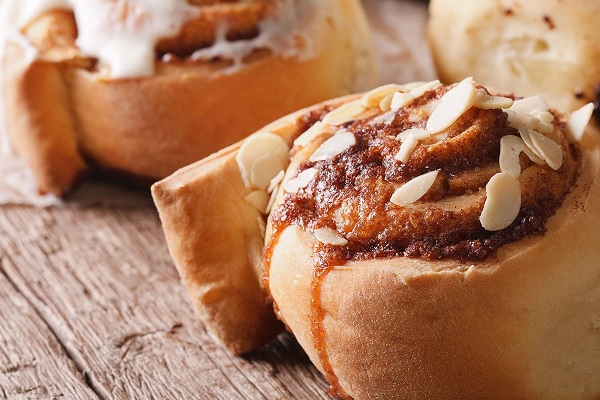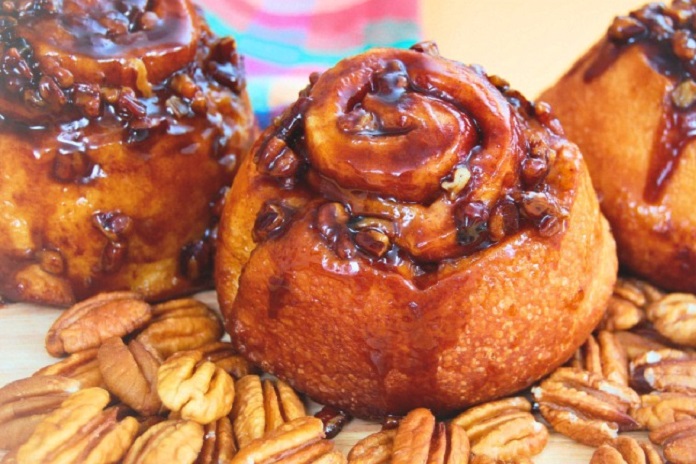On February 21 we celebrate, National Sticky Bun Day a day to enjoy Sticky buns are typically sweet and gooey, with flavours of cinnamon, brown sugar, and buttery richness, often enhanced by nuts or raisins. This is often served in the morning breakfast however sometimes it is also commonly known as cinnamon rolls, caramel rolls or monkey bread.
History of National Sticky Bun Day
However, the exact origins of the sticky bun are debatable, as is the history of National Sticky Bun Day. But while some attribute the sticky bun to the Ancient Egyptians, others argue that it may have originated in Germany. However, some historians revealed that they may have been around in the Western World since the Middle Ages when cinnamon became a more prominent spice in these regions.
However, one thing that is agreed on is that German settlers brought the sticky bun to Pennsylvania in the United States. Specifically, they seem to have been brought and popularized through the Pennsylvania Dutch (Deutsch), many of whom were fleeing religious persecution during the 1700s. These pastries were originally called ‘schnecken’ and are now considered to be a specialty of Philadelphia.
Moreover, when it comes to sticky buns, some clarifications may need to be made since many questions seem to come along with them.
However, one of the main questions is this: what is the difference between sticky buns and cinnamon rolls?
The people who are asked, many people believe that the difference is nuts. Literally, the addition of nuts is what turns a plain old “cinnamon roll” into a “sticky bun”. These nuts are typically pecans but could be of another variety as well.
In addition, sticky buns are stickier. This is because, before they are baked, a caramel glaze is prepared that is poured into the baking dish with nuts prior to adding the dough rolls. Then, when the baking is finished, the rolls are flipped upside down, leaving the sticky, gooey, nutty goodness all on the top of the buns.
Since they don’t have the sticky glaze, cinnamon rolls don’t need to be turned upside down. Instead, they usually have a powdered sugar glaze that is drizzled on the top to give a sweet finish
| 18th century (Origins) | Sticky buns primarily have German origins, known as ‘Schnecken.’ |
| 19th century (Behold, the Sticky Bun!) | German settlers like the Pennsylvania Dutch bring the sweet treat with them to the United States. |
| 1920s (Sweet Sister) | The sticky bun’s sister, the ‘cinnamon bun’ is created in Sweden. |
| 1954 (UBC Specialty) | Hungarian baker Grace Hasz begins selling cinnamon buns daily at The University of British Columbia. |
Sticky Buns Recipe
Ingredients:
For the Dough:
- 1 cup warm milk (about 110°F)
- 2 ¼ teaspoons (1 packet) active dry yeast
- ¼ cup granulated sugar
- 1/3 cup unsalted butter, melted
- 1 large egg
- 1 teaspoon vanilla extract
- 3 ½ to 4 cups all-purpose flour
- 1 teaspoon salt
Filling:
- ½ cup brown sugar, packed
- 1 tablespoon ground cinnamon
- ¼ cup unsalted butter, softened
- ½ cup chopped nuts (optional)
- ½ cup raisins or chopped dates (optional)
Topping:
- ½ cup brown sugar, packed
- ¼ cup unsalted butter
- ¼ cup corn syrup
- ½ cup chopped nuts (optional)
How to make:
- In a large bowl, combine warm milk, yeast, and sugar. Let it sit for about 5 minutes until it’s frothy.
- Add melted butter, egg, and vanilla extract. Mix well.
- Gradually add 3 ½ cups of flour and salt, stirring until a dough forms. If the dough is too sticky, add more flour, a little at a time, until it’s manageable.
- Knead the dough on a floured surface for about 5-7 minutes until smooth and elastic. Place it in a greased bowl, cover it with a cloth, and let it rise in a warm place until doubled in size (about 1 hour).
- In a small bowl, mix brown sugar and cinnamon. Set aside.
- Once the dough has risen, punch it down and roll it out on a floured surface into a rectangle (about 16×12 inches).
- Spread the softened butter over the dough, then sprinkle the cinnamon-sugar mixture evenly on top. Add nuts and raisins if desired.
- Starting from the long edge, tightly roll the dough into a log. Pinch the seam to seal.
- Cut the log into 12 equal pieces.
- In a saucepan, melt the butter, brown sugar, and corn syrup over medium heat until combined and bubbly. Pour this mixture into the bottom of a greased 9×13-inch baking pan. Sprinkle nuts on top if using.
- Place the sliced rolls cut-side up in the pan over the topping. Cover and let them rise again for about 30 minutes.
- Preheat your oven to 350°F (175°C). Bake for 25-30 minutes or until golden brown.
- Allow the buns to cool for a few minutes, then invert the pan onto a serving platter so the sticky topping is on top.
- Serve warm and enjoy the gooey goodness of your homemade sticky buns.

Source: National Today
Tips for Making Perfect Sticky Buns
Here are some of the tips by which to make your sticky buns perfect,
- Measure Ingredients Accurately: Use a kitchen scale for the best results, especially for flour, as too much can lead to dense buns.
- Warm Environment for Rising: Yeast dough benefits from a warm, draft-free environment. You can create this by preheating your oven for a minute, turning it off, and placing the dough inside.
- Don’t Rush the Rising Time: Allowing the dough to rise adequately is crucial for texture. Be patient, as it can take longer in cooler environments.
- Use Fresh Ingredients: Make sure your yeast is fresh for the best rise. Check the expiration date if you’re unsure.
- Experiment with Glazes: Besides caramel, try different glazes like cream cheese frosting or a simple icing made with powdered sugar and milk.
Learn Fun Facts about Sticky Buns
- This day is certainly a day worth celebrating, so sharing these fun bits of knowledge will make it even better when gathering with friends and family:
- Monkey Bread is a variation of sticky buns. Instead of rolling the buns into swirls and slicing them, the dough is made into small balls that are piled high and then baked into their caramel sauce and nuts.
- Another cousin to the sticky bun is the Chelsea Bun, which is a London speciality that features the use of currants or raisins.
- Pecans are typically the nut of choice for sticky buns, but toasted almonds or walnuts would certainly be just as delicious!
- These delicious treats can either be eaten as breakfast or as dessert. And on National Sticky Bun Day, it’s probably best to do both
Activities for National Sticky Bun Day
Here are some of the activities for National Sticky Bun Day,
- Baking Party: Gather friends or family to bake sticky buns together. You can try different recipes or flavours.
- Taste Test: Visit local bakeries and have a sticky bun taste test to find your favourite.
- Decorating Contest: Bake a batch and have a decorating contest, using toppings like nuts, icing, or fruits.
- Sticky Bun Brunch: Host a brunch featuring sticky buns as the star dish, paired with coffee or tea.
- Recipe Swap: Share your favourite sticky bun recipes with friends or online.
- Create a Sticky Bun Bar: Set up a DIY bar with various toppings and fillings for people to customize their own buns.
Conclusion
In conclusion, National Sticky Bun Day offers a day to celebrate one of the sweetest pastries around. However, from the warm, gooey centres to the rich caramel glaze, sticky buns are a treat that can bring joy to any gathering. Whether you’re baking at home, exploring local bakeries, or sharing recipes with friends, this day encourages creativity and togetherness. Hosting a sticky bun brunch or a decorating contest not only adds a fun twist but also creates lasting memories with loved ones. So, embrace the sweetness of the day, indulge in some delicious treats, and enjoy the simple pleasure that sticky buns bring.
FAQs
Can I make sticky buns in advance?
Yes! You can prepare the dough and filling, then refrigerate it overnight before baking. Just let the dough rise at room temperature for about 30 minutes before baking.
Can I use different fillings?
Yes! Feel free to get creative with fillings like chocolate chips, fruits, or different spices.
What’s the best way to reheat sticky buns?
Reheat sticky buns in the microwave for a few seconds or in a preheated oven at 350°F (175°C) for about 10 minutes until warmed through.
Why did my sticky buns turn out dense?
Dense sticky buns may be due to over-kneading the dough or not allowing it to rise long enough. Make sure to follow the rising times and handle the dough gently.
Can I make sticky buns vegan?
Yes, substitute dairy ingredients with plant-based alternatives (like almond milk and vegan butter) and use a flaxseed egg or a store-bought egg replacer.
What’s the difference between sticky buns and cinnamon rolls?
While both are similar, sticky buns are typically topped with a sticky glaze and may include nuts, while cinnamon rolls are often frosted with icing and have no sticky topping.
Also, read more about National I Want Butterscotch Day – February 15, 2025
